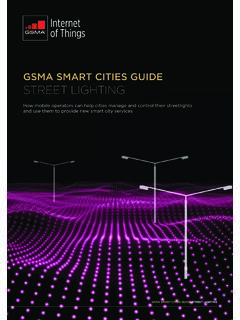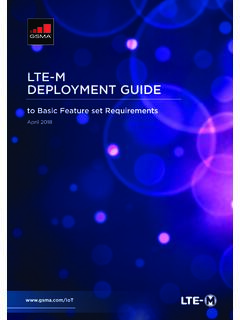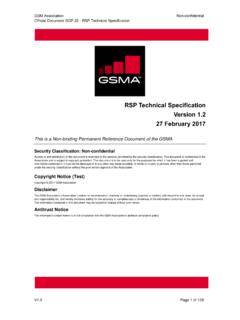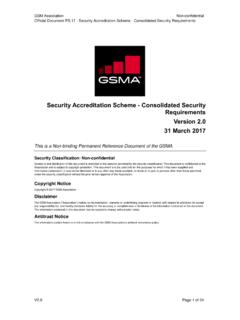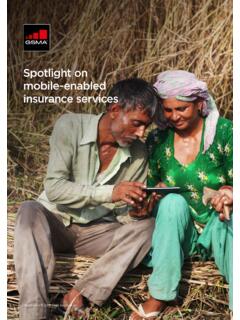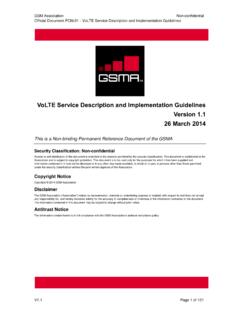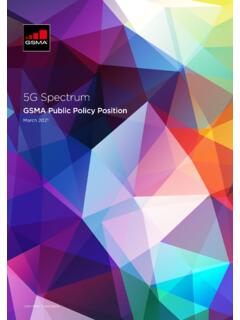Transcription of eSIM Whitepaper - gsma.com
1 ESIM Whitepaper The what and how of Remote SIM Provisioning March 2018 Table of Contents eSIM Whitepaper .. 1 The what and how of Remote SIM Provisioning .. 1 Introduction .. 3 How it Works .. 4 SIM Cards Today .. 4 Remote SIM Provisioning .. 5 The Profile .. 6 Overview of the M2M Solution .. 7 Main System Elements .. 7 SM-DP .. 7 SM-SR .. 8 eUICC .. 8 Compliance .. 8 Overview of the Consumer Solution .. 9 Main System Elements .. 9 SM-DP+ .. 9 LPA .. 9 eUICC .. 10 SM-DS .. 10 Compliance .. 10 Why are there two Solutions? .. 12 Common Features to both solutions .. 12 Unique features of the M2M solution .. 13 Unique features of the Consumer Solution .. 14 Differences in Compliance .. 15 Compliant Devices and Platforms are Essential .. 16 Conclusion .. 17 Annex - Frequently Asked Questions .. 18 3 Introduction The ubiquitous SIM card has played a fundamental role in mobile telecommunications for over 25 years. It is recognised by end users and provides a secure means for authenticating devices onto networks, all inside a removable Secure Element , which is easily transferrable between mobile devices.
2 Although the role of the SIM itself is not changing, the GSMA has defined a radical new way to load it into devices. Now the SIM may be securely downloaded into a Secure Element that can be permanently embedded inside any type of device. To enable this change, an ecosystem of trusted platforms and players has been facilitated by the GSMA to create the eSIM solution. It offers an equivalent level of security and protection to that provided by the removable SIM card. The change from the Removable SIM to an eSIM provides benefits for many players: For everyone, eSIM provides an equivalent level of security as the removable SIM card. This is vital as it is the subscription credentials stored on the SIM card that enable secure and private access to mobile networks. It also supports the integrity of the billing process, especially in roaming scenarios: For the device end user, eSIM enables simplified management of subscriptions and connections. End users will no longer have to manage several SIM cards: For organisations, eSIM enables remote management of subscriptions.
3 This is a significant benefit where devices are not managed by the end user or are not be readily accessible (for example due to operational scale, making individual device management cost prohibitive). This enables pioneering categories of connected devices: For distributors, simplified logistics are possible, customisation for specific operators or regions may be reduced: Operators will have simpler means to expand their businesses into emerging markets, for example, automotive, wearables and consumer electronics. SIM card distribution costs will be eliminated, and eSIMs will enable new distribution models for devices and for marketing of subscriptions: Device Manufacturers, can exploit the reduced space within their products to make smaller devices. Their products could also be made more tolerant to environmental factors such as dampness, temperature and vibration as they can be hermetically (completely airtight) sealed. Manufacturers can also leverage eSIMs to optimise supply chain processes.
4 This document provides both a primer to introduce the basics of Remote SIM Provisioning technology and an introduction to the detailed technical specifications. For more information on GSMA solutions for eSIM (including support material for organisations wishing to deploy eSIM solutions) and enrolment to use the GSMA eSIM logo, please go to 4 How it Works Conceptually the principle behind eSIM is simple. The integrity of traditional SIM cards is safeguarded by using secure facilities for their manufacture, which includes loading of software and operator credentials. Operator logistics channels then distribute the SIM cards to the required endpoints, for example retail shops, retail partners or enterprise customers managing fleets of connected devices. eSIM extends the reach of the secure facilities from specific physical locations, to any location where the device can be reached over the internet. eSIM protocols provide security and integrity for data transfer.
5 This, however, is only one part of the challenge. As well as being secure, the distribution channels for SIM cards also contain business logic which is required by various service models. In some channels that logic may even dictate who has control of device connections. It is not practical to combine this logic into a single technical solution for eSIM. The GSMA has created solutions suited to different types of channels: Consumer solution: for the direct to consumer channel, this solution is required where the end user (or consumer) has direct choice of the operator supplying connectivity. Consumer solutions require a high degree of end user interaction, with the principle that the end user is familiar with operating the end user interface and actively choosing their network connectivity provider. The Consumer solution also targets enterprises who use devices targeted to the consumer market. M2M solution: for the business to business to consumer channels, this solution serves the needs of business to business customers, specifically in the Internet of Things (IoT) market.
6 This section explains the technology at a conceptual level. Later sections provide more detail on the specific technologies used for the Consumer and M2M solutions. For the purpose of this section, the examples given use the consumer model. It should be noted that the M2M model is different in respect that there is no end user interaction as part of profile management and therefore all SIM provisioning operations are managed remotely. SIM Cards Today Today, the traditional SIM card is owned and issued by a specific operator. This model is illustrated in the following figure. 5 SIM Card Operation In (1), the end user sets up a contract with their chosen mobile network operator, and in return they receive a SIM card, which they can insert into their mobile device to enable it to connect to the operator s network. This particular SIM card is marked with a red dot to indicate that the subscription credentials contained within it are issued and authenticated by that operator.
7 Should the end user wish to change operator, they can set up a contract with the new operator (2), and in turn receives a SIM card from that operator (this time marked with a blue dot indicating different subscription credentials). It is obvious to note that even though the end user has this new SIM card in their possession, the mobile device is still connected to the original operator s network. To change operators, the end user must physically swap the SIMs (3). Remote SIM Provisioning With Remote SIM Provisioning, there are no traditional SIM cards1. Instead there is an embedded SIM (called an eUICC), which may be soldered inside the mobile device, that can accommodate multiple SIM Profiles each Profile comprising of the operator and subscriber data that would have otherwise been stored on a traditional SIM card (the red and blue dots in the previous section). An example is illustrated in the following figure. Remote SIM Provisioning Operation Operator Profile Installation In (1), the end user sets up a contract with their chosen mobile network operator, and in the case of a Consumer solution, instead of receiving a SIM card they will receive instructions on how to 1 Although written assuming the eUICC is a permanent fitting in the device ( soldered) it is possible for eSIM deployments to make use of removable SIM formats.
8 6 connect their device to the operator s Remote SIM Provisioning system. In this example a QR ( quick response ) code is used. The QR code contains the address of the Remote SIM Provisioning system (SM-DP+ server within the GSMA specifications), which allows the device to connect to that system (2) and securely download a SIM Profile. Once the Profile is installed and activated, the device is able to connect to that operator s network (3). It should be noted that the use of QR codes is one way that the eSIM solution can be configured within a device, alternatives include pre-configured devices, use of Subscription Manager - Discovery Server and companion devices. Remote SIM Provisioning Operation Operator Profile Selection Should the end user wish to change operator, they can set up a contract with the new operator (4), and in turn receive a QR code from that operator. The device can scan the code to locate and download the new Profile. In (5) the end user is now able to switch between the two Profiles, to connect their device to whichever operator s network the end user selects (6)2.
9 The Profile A Profile comprises of the operator data related to a subscription, including the operator s credentials and potentially operator or third-party SIM based applications. The secure element in the eSIM solution is called the eUICC, this can accommodate multiple Profiles. Profiles are remotely downloaded over-the-air into a eUICC. Although the eUICC is an integral part of the device, the Profile remains the property of the operator as it contains items owned by the operator (IMSI, ICCID, security algorithms, etc.) and is supplied under licence. The content and structure for interoperable Profiles stored on eUICCs are similar to those installed on traditional SIMs. The interoperable description of these Profiles is defined by the SIMA lliance3. 2 With end user consent, an operator may use business rules in their Profile to restrict the ability for the end user to perform operations (4) and (5). 3 7 Overview of the M2M Solution The GSMA M2M solution4 was the first Remote SIM Provisioning solution developed.
10 There were two reasons for this: The M2M solution is simpler as end user interaction is not required, or desirable, in the business to business to consumer (B2B2C) segment, and The immediate commercial need was for technical solutions that supported B2B2C deployments alongside regulatory requirements for the launch of services such as eCall5. Main System Elements Remote SIM Provisioning for M2M utilises a server driven (push model) to provision and remotely manage operator Profiles. The solution is organised around 3 elements: the SM-DP (Subscription Manager - Data Preparation), the SM-SR (Subscription Manager - Secure Routing) and the eUICC. The diagram below is the high-level representation of the M2M main system elements. Beyond common SIM functions, such as SIM Toolkit6 and Bearer Independent Protocol (BIP7) support, the M2M solution does not impose additional requirements on M2M devices to enable usage of eUICCs. M2M Architecture SM-DP The SM-DP is responsible for preparing, storing and protecting operator Profiles (including the operator credentials).


